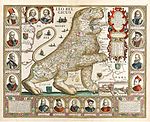| Belgic Gaul | |
|---|---|
| Province of the Roman Empire | |
| 22 BC–5th century | |
 | |
| Capital | Durocortorum (Reims) Augusta Treverorum (Trier) |
| Historical era | Antiquity |
• Established after the Gallic Wars | 22 BC |
• Ended with Frankish Kingdoms | 5th century |
Gallia Belgica ("Belgic Gaul") was a province of the Roman Empire located in the north-eastern part of Roman Gaul, in what is today primarily northern France, Belgium, and Luxembourg, along with parts of the Netherlands and Germany.
In 50 BC, after the conquest by Julius Caesar during his Gallic Wars, it was described as stretching all the way to the Rhine, and one of the three parts of Gaul (Tres Galliæ), the other two being Gallia Aquitania and Gallia Lugdunensis.[1] An official Roman province of this name was later created by emperor Augustus in 22 BC. The province was named for the Belgae, as the largest tribal confederation in the area, but also included the territories of the Treveri, Mediomatrici, Leuci, Sequani, Helvetii and others. The southern border of Belgica, formed by the Marne and Seine rivers, was reported by Caesar as the original cultural boundary between the Belgae and the Celtic Gauls, whom he distinguished from one another.[2]
The province was re-organised several times, first increased and later decreased in size. Diocletian brought the northeastern Civitas Tungrorum into Germania Inferior, joining the Rhineland colonies, and the remaining part of Gallia Belgica was divided into Belgica Prima (in the eastern area of the Treveri, Mediomatrici and Leuci, around Luxembourg and the Ardennes), and Belgica Secunda (between the English Channel and the upper Meuse).
The capital of Belgica Prima, Trier, became an important late western Roman capital.[3]
| History of Belgium |
|---|
 |
|
Timeline • Military • Jewish history • LGBT |
| History of Luxembourg |
|---|
 |
|
|
- ^ Gaius Julius Caesar. The Conquest of Gaul. Trans. S. A. Handford (New York: Penguin, 1982), Caes. Gal. 1.1.1
- ^ "Gallos ab Aquitanis Garumna flumen, a Belgis Matrona et Sequana diuidit.", Commentarii de Bello Gallico
- ^ Gallia Belgica - Edith Mary Wightman - Google Boeken. Books.google.be. Retrieved on 2013-09-07.